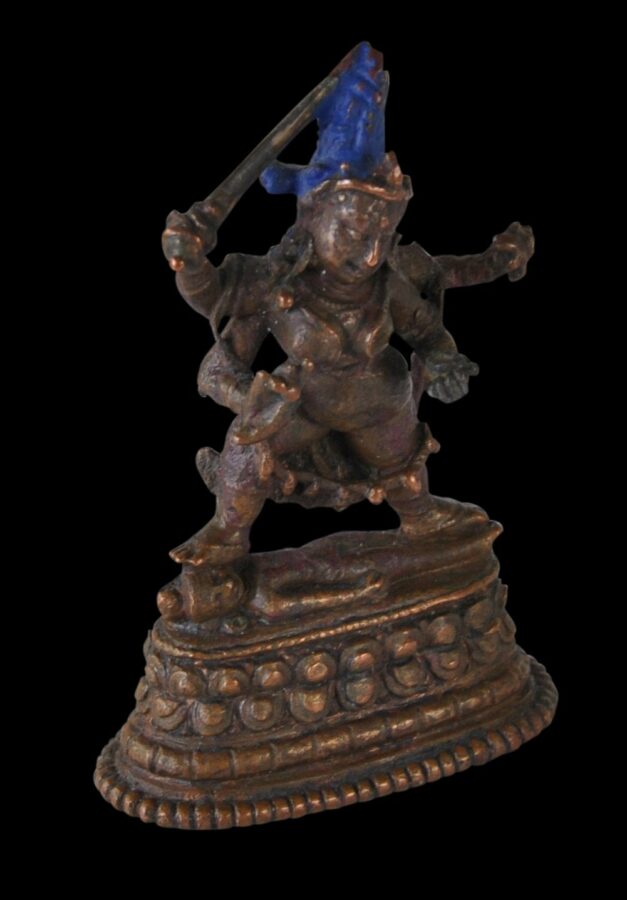This superb small bronze is from 12th century Bihar. Powerfully cast despite its size, it shows a dancing Dakini figure, possibly Acala, It is in excellent condition and does not have the ritual prayer (puja) wear that many Indian bronzes have because it was exported to Tibet where the (Hindu) practice of lustrating and rubbing bronzes was not practiced. Instead they tended to be installed on an alter. Offerings were made to them but rarely were they touched.
The image has four arms, and brandishes a sword in the upper right hand. It has a heavy belly, a broad face with well-defined features, a third eye in relief on the forehead, and flat disk, circular earrings – which are notably Indian. A prominent three-leaf crown or perhaps chignon on the head has been coloured with blue, probably Reckitt’s Blue, a whitening agent for washing clothes produced in England and exported across the British Empire, where many alternative uses for it were found particularly among indigenous peoples who used it to colour wooden and brass sculpture from Africa to Tibet (where it was traded in from India).
The image stands on a prostrated figure, and on a double-lotus base of elongated oval form, over a stepped plinth.
The image is solid cast from a dark brass alloy, and the base is hollow.
The worship of Dakinis originated in India between the 10th and 12the centuries. The practice then spread to Tibet. In Tibet, this form most probably would have been regarded as Achala.
The Pala Dynasty flourished in eastern India from the 8th to the 12th century and produced distinctive artforms influenced heavily by the Gupta aesthetic. The double-lotus base over a stepped plinth became used widely during this period. The body of svelte form sways to the figure’s right. The sway and the broad face are typical of 12th century Pala-Bihar images. Another interesting Pala characteristic is a horizontal bar that is cast to the back of the head which is present in many Pala period images of this type, including this one (Heller, 2008, p. 138).
Tibetan casters copied the Pala Indian style and bronzes based on this style soon were produced locally.
There are minor old losses to some of the extremities such as to part of the hoop of the left earring.
References
Heller, A., Early Himalayan Art, Ashmolean Museum, 2008.
Pal, P., Indian Sculpture, Volume 2 – 700-1800, Los Angeles County Museum of Art, 1988.
Pal, P., Art from the Indian Subcontinent: Asian Art at the Norton Simon Museum, Yale University Press, 2003.
Prats, R.N. et al, Monasterios y Lamas del Tibet, Fundacion ‘la Caixa’, Barcelona, 2000.
Reynolds, V. et al, From the Sacred Realm: Treasures of Tibetan Art from the Newark Museum, Prestel, 1999.








